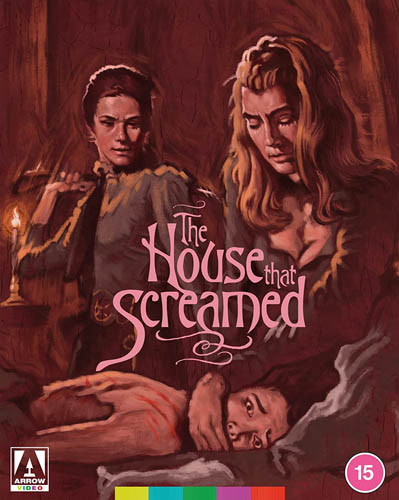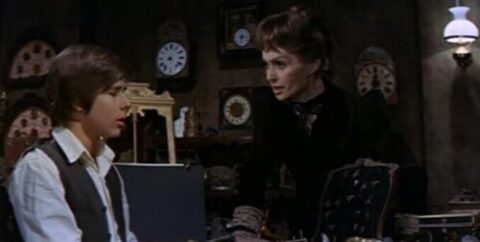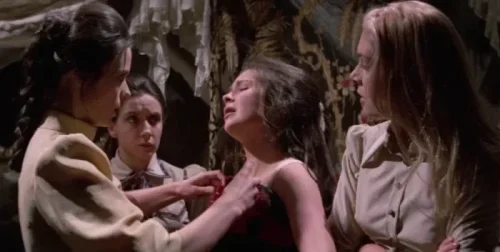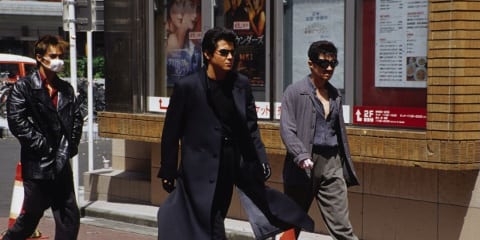The House That Screamed (1969)
Directed by: Narciso Ibáñez Serrador
Written by: Juan Tébar, Narciso Ibáñez Serrador
Starring: Cristina Galbó, John Moulder-Brown, Lilli Palmer, Maribel Martín
AKA LA RESIDENCIA, THE FINISHING SCHOOL
SPAIN
AVAILABLE 6TH MARCH, from ARROW VIDEO
RUNNING TIME: 105 mins / 94 mins
REVIEWED BY: Dr Lenera

In 19th Century France, eighteen-year-old Teresa Garan arrives at a boarding house for wayward girls where the strict headmistress Ms. Fourneau runs the place like a prison. She has a son, Louis, who’s too ill to go off to college and who likes to peep at the girls. She doesn’t want him seeing any of the students, but he has clandestine meetings with some of them anyway, And she has a protege, the wicked student Irene Tupan, who keeps watch over the others and bullies and torture them to maintain strict control. Irene is involved in covert activities which she keeps secret from Ms Fourneau, such as deciding which girls can join a man delivering weekly loads of firewood in a barn for sex. Teresa thinks that she’s being watched and followed ,Irene takes a special interest in her, while three students have disappeared. It’s assumed that they sneaked away at night, but did they actually escape….

I’m not as up on my Spanish horror as I ought to be [I still have yet to see a Paul Naschy movie though I’ve suffered through six and a half Jess Franco ones], but I know that The House That Screamed, directed by Narciso Ibáñez Serrador who made only one other feature film [the just as notable Who Can Kill A Child?], is regarded as a seminal work, and not just because it influenced Suspiria, right down to Cristina Galbó’s mannerisms and expressions being very much mimicked by Jessica Harper in the Dario Argento classic, but it’s a hugely fascinating and effective work in its own right. You could definitely call it a Spanish giallo, with it certainly featuring a killer on the loose [albeit a killer whose identity is so obvious that one wonders if it was ever intended to be an actual mystery at all], not to mention it also containing a pretty grisly conclusion which may have inspired one in a 2002 horror film but which still shocks. However, it’s as much or even more a dark drama about sexual repression and unease, taken at a leisurely pace [especially in the longer version] but absolutely oozing with tense atmosphere of both the human and the Gothic kind that always threatens to boil over. The school setting is a terrific example of Gothic production design, as if Hammer’s famed set designer Peter Robinson had been let loose with a bigger budget to play with than usual, while there are probably more scenes of people wondering down corridors than in any Roger Corman or Mario Bava movie. Of course most of its elements soon became used a great deal, but they weren’t very prevalent at the time, and, while some first-time viewers used to films of this nature being more explicit may be disappointed in the low amount of on-screen sex and violence, it’s worth remembering that censorship in Spain had been among the tightest out of European countries, and this film not just helped to get the ball rolling in terms of loosening things up, but is in itself clever the way it manages to depict and suggest certain things which would have been taboo while keeping to certain restrictions of the time.
So we begin with Teresa and a man who I guess is her guardian arriving at the school, music soaring ironically as they approach the front which looks very forbidding indeed. In one of the classrooms Headmistress Fourneau is reciting some words which the pupils have to copy down, but rebellious Catherine is refusing to do so. A tough cookoe, she’s already been punished for acting this way before, but continues to show defiance when it’s clear that she’s going to be punished again. Ms Fourneau calls Irene to takes Catherine off to the “seclusion room”, though it’s not just for seclusion. Several scenes later, we return to Catherine, and we see that Ms Fourneau, Irene her protege, and two of Catherine’s class mates are present. Catherine still won’t apologise, so Irene rips off her top and whips her. Initially we cut away to the other girls saying prayers before the first lash, cheating the viewer and perhaps making him or her feel guilty about being disappointed at not being able to see some brutality. But then we twice cut back to the violence and Irene sure does whip her a lot, even delivering an extra two strokes after Ms Fourneau has told her to stop! Ms Fourneau then acts as if she needed this to happen yet didn’t enjoy it. “Try to understand my position”, “I’m sorry”, “Get some sleep, I know I won’t”, the emotionally manipulative nature of which is probably more unsettling than the whipping we’ve just seen. Meanwhile Teresa is shown around the place and somebody seems to be following her and shutting doors, maybe as a sort of game. The culprit turns out to be Ms Fourneau’s son Louis, whom she tells off for shadowing Teresa. She doesn’t want him to make friends with the other girls, claiming that none of them are good enough for him, before kissing him on the side of his chin. Yes, the incestuous element is quite clear, as is lesbianism [though of the predatory mature common at the times] when Irene offers Teresa favours for doing what she tells her before stroking her hands.
All this and other goings-ons are so interesting that we don’t mind the fact that nothing exciting happens for some time. Especially intriguing is the dynamic between Ms Fourneau and Irene. The latter is the former’s pupil and is perhaps intended by her to take over when she retires or passes away, but seems to be even more interested in cruelty. She also does things behind Ms Fourneau’s back, which she’s sure she can get away with because she tells others that it’s for the good of the school. Most notably, she sends girls off to have sex with Henry, who delivers firewood. Does she do this just to pay Henry instead of money, or is there a even more twisted motif? We aren’t told, just as we aren’t told a lot of things, but that doesn’t really matter in a film of this sort. Louis is busy going against his mother’s wishes, meeting up with a girl named Isabelle and convincing her that the two of them will soon get out of there. Mother’s footsteps are heard coming down the hallway – and that’s the last we see of Isabelle. However, Louis has been having secret encounters with another girl too, and leaves two keys in her bed along with a note telling where to go, but while waiting in the greenhouse for him somebody stabs her to death. It seems that the missing girls may well have tried to leave, but were murdered. Loius and Teresa first meet when he’s trapped in a tube while spying on the girls in the shower room, but here’s some odd storytelling. She hears his banging so we can assume that she rescues him, but we don’t see this, nor any of the other meetings between the two that we’re later told about except for the very last one. Ms Fourneau knows that Louis is meeting some girl and doesn’t know who, yet surely this can’t be intended as a mystery for the viewer? Likewise, I doubt that the reveal of the killer surprised many even in 1969, though surprises are still plentiful, including not one but two switches of main protagonist.

The girls shower with their clothes on except for one who eventually takes her garment off, to wind Ms Fourneau up more than anything else, though even then we don’t see anything, yet we’re fascinated by the way Ms Fourneur, who doesn’t normally oversee shower day, seems scared of what she sees. She and Irene are clearly both lesbians, so the obvious thing would probably be for them to get together, but this isn’t even suggested, partly of course because most films of the time wouldn’t have had such a thing happen, and partly because she’s also very interested indeed in her son. “You need a woman like me” she purrs before kissing him on the lips and the image is consumed by yellow and red before we pan out from a painting in one of Serrador’s most stylish flourishes. Ms Fourneur is lost in her own world, unable to confront her deep sexual instability and instead obsessively trying to correct naughty girls, perhaps because of something that she did in the past [get pregnant and have Louis?], while Irene just gets off on power and manipulation but is at least more honest about what she likes. Meanwhile the girls all have to walk about in a regimental fashion and sit at dinner except for one poor lass who has to recite a story about “wicked love” while the others are eating, yet refer to sex and reproduction in the greenhouse and we see nudes, though female nudes, on a painting one of them has obviously done. And shagging certainly goes on in that shed, with lucky Henry seemingly able to make his way through the girls, though a proper depiction of sex was obviously not allowed yet in the cinema of Spain, so, just before a sex scene between Henry and Suzanne, who’s been there before, can go beyond a kiss, we cut away to the other girls back in the house, with some very extreme closeups of faces and some sowing which get faster. We know that each of the girls is thinking about what Suzanne is doing, so much so that we probably didn’t need the audio of the sex added as well, but it’s only Suzanne’s sounds, and is an unusual and rather erotic touch anyway.
As for violence, one slashing is shown with a repeatedly plunging knife superimposed over a gored stomach, a hand over a mouth and flowers so nothing is too clear, which works rather well, though a freeze frame during another one isn’t so effective. The gruesome climactic reveal, plus an open final scene which ends things on a harrowing note, hit us, though maybe the most intense moment is one of mostly verbal humilation, when Irene taunts Teresa for her mother having worked in cabaret, and thereby maybe having been a prostitute; it might not sound like much, but it’s quite upsetting, and one of several moments where the generally fairly still camera[s] of cinematographers Manuel Berenguer and Godofredo Pacheco becomes handheld and chaotic. Despite us being shown around the slightly decaying school early on, the feel is generally quite claustrophobic for some time until things become increasingly Gothic, eventually bursting out with a tremendous escape set piece where everything is brought out, from billowing curtains to candelabra to thunder. The lead-up to the climax is an example of brilliantly achieved and drawn out suspense, with a very powerful feeling of dread; the music score of Waldo de los Rios helps so much here. Palmer’s tremendous performance, which throughout builds on what the screenplay often merely hints at or adding what it doesn’t suggest at all while maintaining admirable subtlety, truly reaches heights in the final section. Mary Maude as Irene is able to be very sinister even when not saying anything bad, and then there’s the fascinating John Moulder-Brown, an unusual presence, so bland in Vampire Circus yet so strong in Deep End where he played another lad with sexual issues. Here in this earlier role he often seems awkward, but is able to soar when a lot is asked of him. What a shame he slipped into mostly undistinguished TV roles in the mid ’70s.
For some time, most of what we hear on the soundtrack are different arrangements of a simple theme with a romantic feel, but just as its becoming overused, we realise that it’s been employed ironically and nerve-jangling mood cues, often with some very creepy sounding electronic sonority, take over, though some lyricism remains in a very excellent score indeed [“Doc goes and sees if it’s ever been released”]. There are some plot elements that are hard to swallow, such as why doesn’t Ms Fourneau notify the authorities when students go missing, and a perhaps allegorical political element isn’t any deeper than telling us that power results in sexual abuse, but The House That Screamed should be a real discovery if you haven’t seen it before.
Rating: 









Brand new 2K restoration from the original negative by Arrow Films
A cursory amount of research reveals that The House That Screamed hasn’t had a good home viewing history. The full version was only available on disc on the grey market for many years and even releases of the cut version, the one released in North America by AIP, weren’t great. Scream Factory’s Region A Blu-ray included both cuts, but the longer one employed video inserts for the bits not in the AIP version. It seems that a good copy of the director’s cut just wasn’t available at the time, but Arrow certainly found one, meaning that the AIP cut could just be recreated from that. The film is very brown-heavy, which may not have looked very good in earlier releases, and there are a few shots which are grainier than the rest, but this restoration is no doubt still a godsend for fans of this film. Detail is very strong throughout and even different shades of black are easily handled.
High Definition (1080p) Blu-ray presentations of the 105-minute uncut version titled The Finishing School (La Residencia), and the 94-minute US theatrical version titled The House That Screamed, via seamless branching
I flicked through the US version after watching the full cut properly. The opening of the carriage arriving at the school is removed, which doesn’t really do any harm, and the tour of the place is shortened, which weakens the sequence in my opinion though I can see why this was done. I’ll be honest; I didn’t notice any other cuts except for a throat slashing which pauses the action just before the bloodletting; this works well because a freeze frame was employed similarly in an earlier killing. I imagine that the other edits were just scenes being tightened up. While I didn’t watch this cut in full, it seems that in general the cutting in order to speed up the pace a little was done well, with none of the film’s flavour and effect lost.
Original lossless English mono audio on both versions, and lossless Spanish audio on the uncut version
On the special features, three people tell us that The House That Screamed was shot in English, and everybody does appear to be speaking it. However, the English audio somehow has a bit of that dubbed flavour, one cockney character doesn’t sound right, and one person says that it was filmed silent as most films of this type and era were, then dubbed afterwards. So which is it?
Optional English subtitles for the deaf and hard-of-hearing on both versions, and optional English subtitles for the Spanish audio
Brand new audio commentary by critic Anna Bogutskaya
Despite her Eastern European-sounding surname, Anna begins her track by telling us that she’s actually Spanish, which is nice as this is a Spanish film. She then goes through a brief biography of its director before commencing a more scene-specific approach. I wish other talkers would to this, get this kind of stuff out of the way as it’s often the least interesting material if you know about the people being detailed – though saying that, I knew little about Serrador, who achieved fame in his native country for creating Historias para no dormir, a Twilight Zone-style series in the 1960’s which has been redone and referenced many times since. Unlike in some cases where the commentator doesn’t see, to be very enthusiastic despite claiming to love the film he or she is talking about, Anna often has trouble trying to tone down her sheer delight at talking about this movie, and it’s great to hear. There’s lots of clever observations of scenes, some pointing out of perhaps daft-seeming but probably intentional symbolism like Louis in the tunnels being a sexual metaphor, and nice bits of info like the original story being set in a boy’ s school and Serrador maybe basing Louis on himself, he having been a lonely child with a strict mother. There are lots of gaps, but overall this is quite a fresh track with a lot to interest. I hope Bogutskava does more.
This Boy’s Innocence, a previously unreleased interview with actor John Moulder-Brown [24 mins]
Understandably proceeded by a spoiler warning, please don’t watch this if you haven’t seen the film, even if I don’t agree with Moulder-Brown when he says that the identity of the killer is s major mystery. He does though describe his character perfectly, no to mention Serradoras “austere” and “intellectual“, and talks of how his peeping scene took ages to film because they kept changing the set. Of course, due to his age, he wasn’t actually allowed to see the film when it came out, but he seems happy to talk at length about the movie which commenced the adolescent stage of his career. This replaces a different interview on the Scream Factory.
Archive interview with Mary Maude, from the 2012 edition of the Festival of Fantastic Films [12 mins]
Maude tells of how she read for most of the girls then was told that she had the large part of Irene because the previous actress was either fired or walked out, that filming took a long time because they’d keep changing sets, and describes Serrador as “a bit peculiar” and that “he could be unkind”. Meanwhile Palmer would have three assistants all called Carmen. There’s an obvious edit towards the end of this interview, signifying that some material has been cut, though not by Arrow as the same interview has the same length on the Scream Factory. I wonder why.
All About My “Mama”, a brand new interview with Juan Tébar, author of the original story [9 mins]
Tébar, whose favourite themes are horror and childhood, talks of his working with Serrador on Historias Para no dormir, how he suggested his tale Mama for that series but Serrador wasn’t interested in it until he decided he wanted to make a film, and that “some actresses and crew members walked out”. It seems that Serrador really wasn’t the nicest of directors to work with and that it was a troubled shoot. Perhaps unsurprisingly, there’s been attempts to remake The House That Screamed and to turn it into a TV series.
The Legacy of Terror, a brand new interview with the director’s son, Alejandro Ibáñez [13 mins]
We begin by learning that Serrador created the game show 1, 2, 3, which became 3, 2, 1 in the UK. He also had a father who was something of a horror star in Argentinian cinema. Alejandro recalls spending much of his childhood on various sets but never thought that this was anything special, and says that his father knew that the only way to get the shower scene approved by the censors was to have the girls naked in the script, then have them clothed which was seen as doing what the censors wanted though if even that, if submitted initially, it wouldn’t have got through otherwise. Alfred Hitchcock would often do this kind of thing.
Screaming the House Down, a brand new interview with Spanish horror expert Dr Antonio Lázaro-Reboll, discussing the history of the film and its director [20 mins]
This does repeat much material seen and heard elsewhere on this disc, so it might be worthwhile to begin with it as it’s more an overview of the film than the other featurettes, than watch the others a few days later. New information includes horror never having been much of an genre in Spain before, and the films that did come out didn’t have a Spanish setting. He says that the film came at a time when Spain had a conflict between tradition and modernity, and that the whipping and shower scenes were heavily cut in Spain, reducing the film’s running time to 99 minutes, but if that was the case, then it’s surprising that the chopped up versions of these scenes aren’t in the feature listed directly below this one.
Alternative footage from the original Spanish theatrical version [6 mins]
The Spanish language titles are followed by an insert of a letter in Spanish, the strongest incestuous bit losing a closeup of a kiss, and an alternate angle.
Original trailers, TV and radio spots [5 mins]
Image gallery
Reversible sleeve featuring original and newly commissioned artwork by Colin Murdoch
FIRST PRESSING ONLY: Illustrated collector’s booklet featuring new writing on the film by Shelagh Rowan-Legg and double-sided fold-out poster featuring original and newly commissioned artwork by Colin Murdoch
I’m rather annoyed that it took me this long to see “The House That Screamed”, but it turned out to be just as good as its reputation. Arrow’s typically thorough release probably won’t be bettered in these sadly dying days of physical media. Highly Recommended!





Be the first to comment